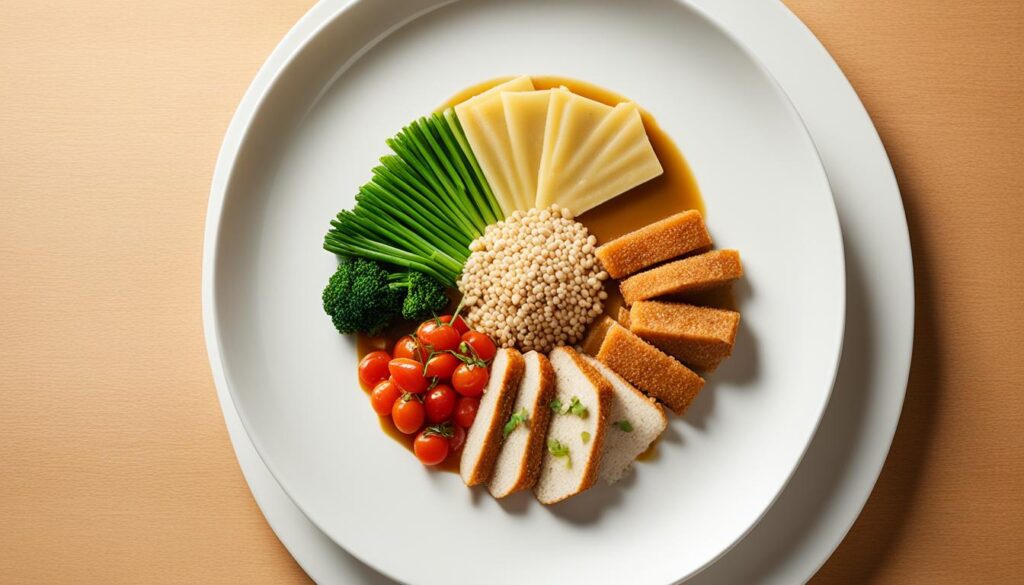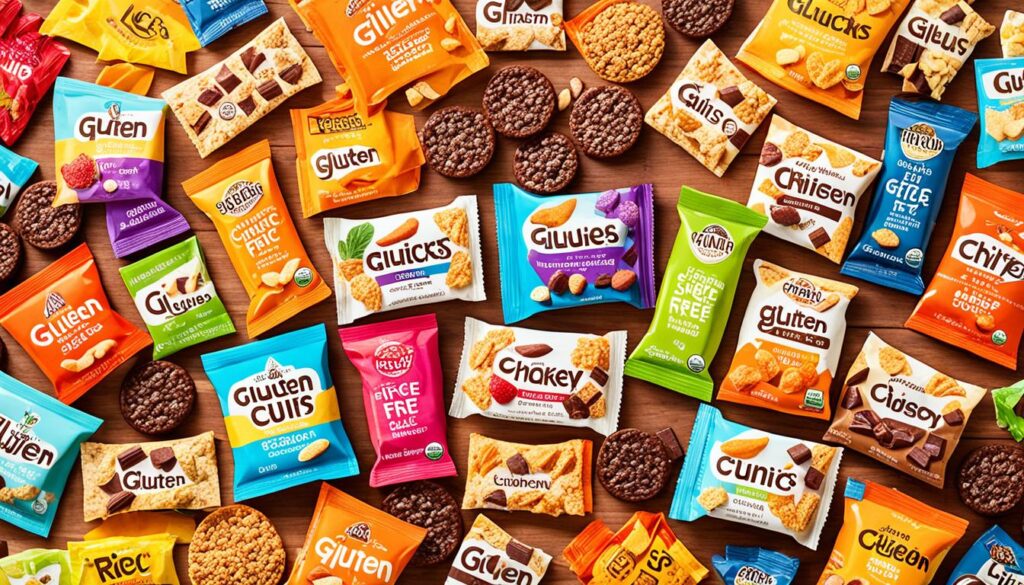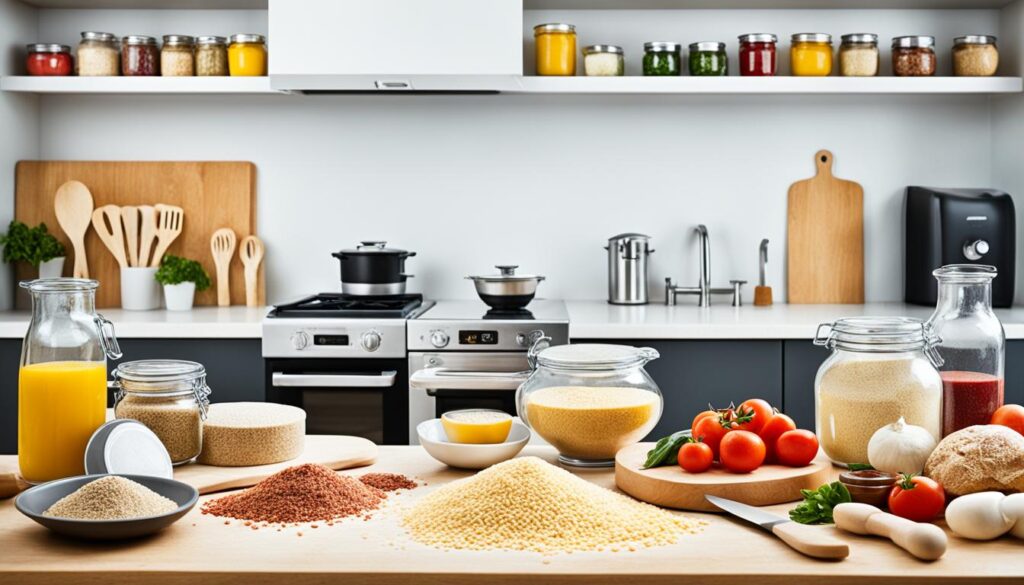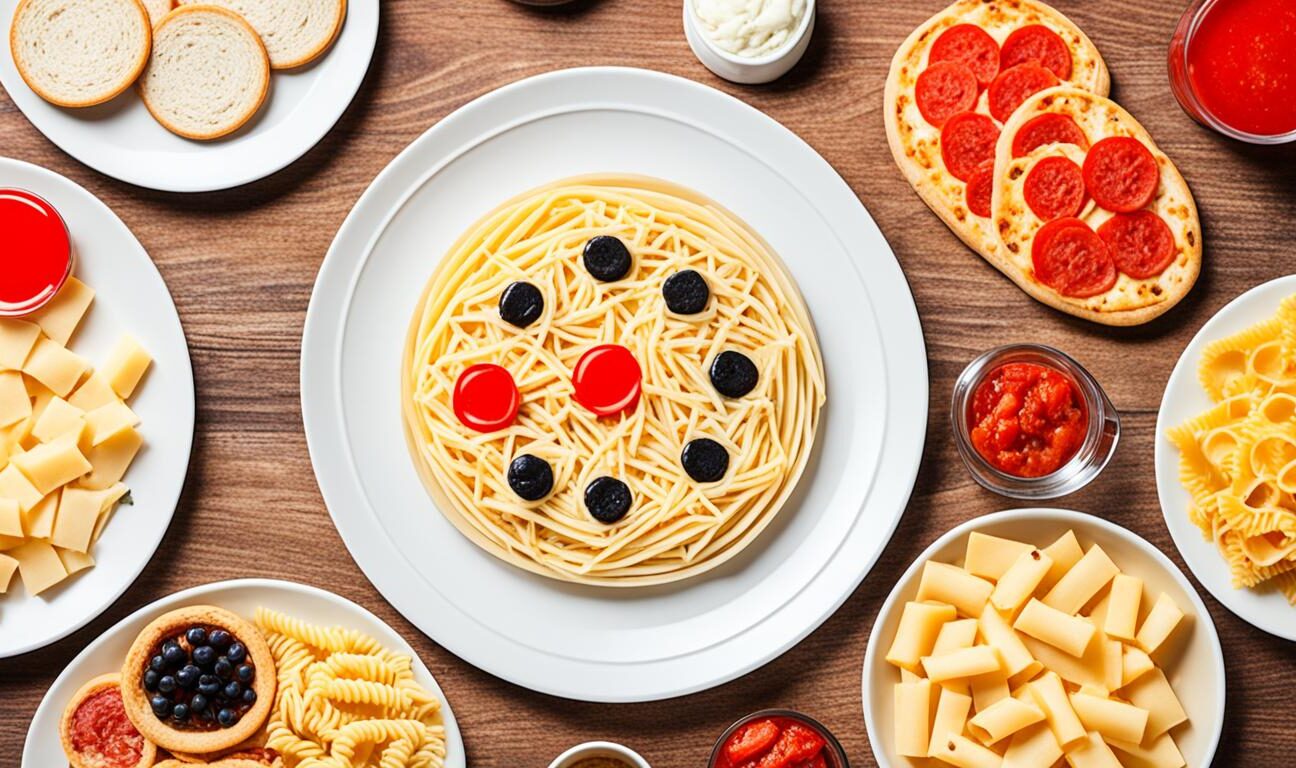Living with celiac disease means I must follow a strict gluten-free diet. This autoimmune disorder makes my body react badly to gluten, a protein in wheat, rye, and barley. Even a tiny bit of gluten can cause an immune response, harm my small intestine, and lead to bad symptoms.
This guide will cover the foods to avoid with celiac disease. It will also talk about gluten-free options and the symptoms of celiac disease. Knowing what to eat can help you manage your health and live a happy, gluten-free life.
Key Takeaways
- Celiac disease is an autoimmune disorder that requires a strict gluten-free diet
- Consuming gluten can trigger an immune response and damage the small intestine
- Identifying and avoiding gluten-containing foods is crucial for managing celiac disease
- Exploring gluten-free alternatives can help you maintain a balanced, nutritious diet
- Understanding the common symptoms of celiac disease can aid in early diagnosis and treatment
Understanding Celiac Disease
Celiac disease is a chronic autoimmune condition caused by gluten. Gluten is a protein in wheat, barley, and rye. When people with celiac disease eat gluten, their immune system attacks the small intestine. This leads to symptoms and health problems.
What is Celiac Disease?
Celiac disease is an inherited disorder. The body mistakes gluten as harmful. This causes damage to the small intestine, making it hard to absorb nutrients from food. Doctors diagnose it with blood tests, genetic tests, and small intestine biopsies.
Symptoms of Celiac Disease
- Digestive issues: Abdominal pain, bloating, diarrhea, constipation, and nausea
- Nutrient deficiencies: Anemia, osteoporosis, weight loss, and fatigue
- Skin problems: Dermatitis herpetiformis, a blistering skin rash
- Other symptoms: Headaches, joint pain, and depression
The symptoms of celiac disease vary a lot from person to person. Some people may not show any symptoms at all. This makes it hard to diagnose, especially in cases of non-celiac gluten sensitivity or gluten intolerance.
“Celiac disease is an autoimmune disorder that can have a profound impact on an individual’s health and well-being. Understanding the symptoms and seeking proper medical care is essential for managing this condition effectively.”

The Gluten-Free Lifestyle
For people with celiac disease or non-celiac gluten sensitivity, going gluten-free is key. It’s vital for those with celiac disease to stick to a strict celiac disease diet. This helps manage their health and stay well.
Understanding why this diet is important helps us see how crucial a gluten-free lifestyle is.
Why Go Gluten-Free?
The main reason for a gluten-free diet is to avoid gluten. Gluten is in wheat, barley, and rye. For those with celiac disease, gluten causes an immune reaction that harms the small intestine.
This can lead to stomach problems and even serious health issues if not treated.
Those with non-celiac gluten sensitivity may feel bloated or tired after eating gluten. Cutting out gluten can make them feel better and healthier.
Going gluten-free also prevents long-term health problems like poor nutrition, weak bones, and some cancers. Sticking to a gluten-free diet helps keep these conditions under control and lowers the risk of future health issues.

“A gluten-free lifestyle is not just a dietary choice, but a necessary step for managing celiac disease and non-celiac gluten sensitivity effectively.”
Grains to Avoid
If you have celiac disease, it’s important to avoid grains with gluten. Gluten is a protein in some grains that causes an immune reaction in people with celiac disease. Eating foods with gluten can lead to health problems and symptoms. To keep a healthy celiac disease diet, you need to know which grains to avoid:
- Wheat (including durum, emmer, spelt, and farina)
- Barley
- Rye
- Triticale (a mix of wheat and rye)
Some grains might not be as well-known but also have gluten and should be avoided. These include:
- Bulgur
- Semolina
- Couscous
- Kamut
Always check food labels and watch what you eat. Even a little gluten can affect people with celiac disease. Sticking to a gluten-free diet helps manage your condition and keeps you healthy.

“Avoiding gluten-containing grains is essential for managing celiac disease and maintaining a healthy lifestyle.”
Processed Foods to Steer Clear Of
Following a celiac disease diet means being careful with processed foods. Many products seem safe but can have hidden gluten. Always check food labels closely.
Reading Food Labels
Reading food labels can be tough, but it’s key for a gluten-free life. Here are tips to spot gluten in ingredients:
- Look for “gluten-free” on the packaging to know it’s safe for those with celiac disease.
- Avoid ingredients with “wheat,” “barley,” “rye,” or “malt.” These contain gluten and should be avoided.
- Be cautious with processed meats like hot dogs and sausages, as they might have gluten.
- Don’t go for sauces, gravies, and dressings, as they often have gluten.
- Watch out for gluten in candy, condiments, and some medications too.
By learning to read labels well, you can shop safely and keep your celiac disease diet right. Remember, even a little gluten can cause bad symptoms. So, it’s best to be careful.
Being alert and informed about what to avoid is crucial for a gluten-free lifestyle. With practice, you’ll get better at spotting gluten and making healthy choices.
Celiac Disease Diet: Hidden Sources of Gluten
Following a strict celiac disease diet can be tough. Gluten hides in places you might not expect. It’s not just about avoiding bread, pasta, and baked goods. There are many hidden gluten sources that can surprise even careful celiac disease patients.
Sauces and condiments are often a surprise source of gluten. Things like soy sauce, salad dressings, marinades, and gravy might have wheat-based thickeners or flavorings. Always check the labels and choose gluten-free options when shopping.
Medicines and supplements can also contain gluten. Some pills and capsules have wheat-based fillers or coatings. Always talk to your doctor and pharmacist to make sure your medicines are gluten-free.
- Sauces and condiments, such as soy sauce, salad dressings, and marinades
- Medications and supplements, including pills and capsules
- Processed foods, like lunch meats, hot dogs, and canned soups
- Certain alcoholic beverages, such as beer and some wines
Being careful and learning about hidden gluten sources is important for a good celiac disease diet. By being informed and proactive, you can shop and live with confidence. This way, you can avoid gluten and focus on your health and well-being.

“Gluten can lurk in the most unexpected places, so it’s crucial to read labels and ask questions to ensure you’re truly following a gluten-free diet.”
Gluten-Free Bread and Pasta Alternatives
Living with celiac disease means you have to follow a gluten-free diet. This can make it hard to enjoy foods like bread and pasta. But, there are now many tasty and healthy gluten-free options available.
Exploring Gluten-Free Flours
Choosing the right flour is key to making great gluten-free baked goods. Since wheat flour is not an option for those with celiac disease, there are other flours you can use. These include:
- Almond flour: It’s full of protein and healthy fats, making it great for baking breads, muffins, and more.
- Coconut flour: This flour adds a unique flavor and texture to gluten-free baked goods.
- Rice flour: It’s a common choice for gluten-free cooking and can be used for everything from pizza crusts to pasta.
- Quinoa flour: Coming from the superfood quinoa, this flour is packed with protein and fiber.
Trying out different gluten-free flour mixes can help you find the perfect taste and texture for your homemade gluten-free bread and gluten-free pasta.
| Gluten-Free Flour | Nutritional Benefits | Best Uses |
|---|---|---|
| Almond Flour | High in protein and healthy fats | Baking, breads, muffins |
| Coconut Flour | High in fiber, low in carbs | Baking, pancakes, waffles |
| Rice Flour | Naturally gluten-free, versatile | Breads, pasta, pizza crusts |
| Quinoa Flour | Protein-rich, nutrient-dense | Baking, pasta, cereals |

“Embracing the world of gluten-free flours has opened up a whole new realm of culinary possibilities for those with celiac disease.”
celiac disease diet, gluten-free foods, celiac symptoms
People with celiac disease need to follow a strict gluten-free diet. This helps them avoid symptoms caused by gluten. Even a small amount of gluten can start an immune reaction in those with celiac disease.
Gluten is a protein in wheat, rye, and barley. Those with celiac disease must avoid foods with these grains. This includes many foods like bread, pasta, cereals, baked goods, and some condiments and processed items.
- Common foods to avoid on a celiac disease diet include:
- Bread, crackers, and pastries made with wheat, rye, or barley
- Pasta and noodles made from gluten-containing grains
- Cereals, granola, and other breakfast items containing gluten
- Beer, ale, and other beverages made from gluten-containing grains
- Sauces, gravies, and condiments that may contain gluten
There are many gluten-free options available for those with celiac disease. These include gluten-free flours, breads, pastas, and foods like fruits, vegetables, meats, and dairy products.
Following a gluten-free diet and being careful about hidden gluten sources helps manage celiac disease symptoms. Regular talks with healthcare providers and sticking to a gluten-free life are important. This way, people with celiac disease can live a healthy, fulfilling life.

“Celiac disease is a serious autoimmune disorder that can have long-term health consequences if not properly managed through a strict gluten-free diet.”
Dining Out with Celiac Disease
Dining out with celiac disease can be tough. But, with the right tips and approach, it can be safe and fun. Let’s look at some great advice for eating out gluten-free.
Tips for Gluten-Free Dining
Telling restaurant staff about your celiac disease is key. Always let your server know you need a gluten-free meal. It’s okay to ask lots of questions about the menu and how things are made.
- Look for gluten-free restaurants and menus in your area. This makes finding a safe place to eat easier.
- Check the menu for dishes that don’t have gluten, like grilled meats, roasted veggies, and salads with gluten-free dressing. Stay away from items with sauces or breaded toppings.
- Ask if you can change menu items to make them gluten-free. Many places will help if you ask nicely.
- Make sure to ask your server about your meal’s preparation. If you’re worried about gluten, send it back if needed.
Being proactive, clear, and careful helps people with celiac disease eat out safely. With some planning and speaking up, the celiac disease diet won’t stop you from trying new foods. And you can still enjoy eating at gluten-free restaurants.

“Dining out with celiac disease requires extra care and attention, but it’s not impossible. With the right knowledge and a willingness to speak up, you can find delicious and safe gluten-free options.”
Gluten-Free Snacks and Treats
Living with celiac disease doesn’t mean you have to miss out on snacks and treats. Today, the gluten-free market offers many tasty options. These options let you enjoy your cravings while sticking to a celiac disease diet.
You can find everything from crunchy chips and crackers to rich cookies and brownies. Let’s look at some gluten-free snack ideas. These will make your taste buds happy and keep you healthy.
Satisfying Salty Cravings
When you want a salty snack, try these gluten-free choices:
- Baked vegetable chips from kale, sweet potatoes, or beets
- Roasted chickpeas or edamame for a protein-rich snack
- Gluten-free pretzels or crackers with nut flours or ancient grains
Indulging in Sweet Treats
If you love sweets, the gluten-free world has great news. Enjoy:
- Chewy, gooey gluten-free brownies with almond or coconut flour
- Soft, fluffy gluten-free cookies in your favorite flavors
- Creamy, rich gluten-free ice cream or frozen treats
Always check labels for “gluten-free” to make sure they fit your diet.

Exploring a bit, you’ll find many tasty gluten-free snacks and treats. These can be part of a balanced celiac disease diet. Enjoy these treats without guilt and let the flavors delight you.
Cross-Contamination Concerns
Living with celiac disease means you must follow a strict gluten-free diet. But, it’s not always easy. One big worry is cross-contamination. This happens when gluten touches gluten-free foods, making them unsafe to eat.
Keeping Your Kitchen Gluten-Free
To avoid cross-contamination, you need to be careful in the kitchen. Here are some tips to help you stay on track with your celiac disease diet:
- Keep gluten-free and gluten-containing foods separate, using different shelves or containers.
- Use separate utensils, cutting boards, and cookware for each type of food.
- Clean all surfaces, utensils, and cookware well before and after use to remove gluten.
- Don’t share condiments like butter or jam that could have gluten in them.
- Always check labels to make sure all ingredients, including spices and sauces, are gluten-free.
Following these steps will make your kitchen safe for your celiac disease diet. You’ll be able to enjoy many tasty, gluten-free meals.
| Cross-Contamination Risk | Preventive Measures |
|---|---|
| Shared utensils, cookware, and surfaces | Use dedicated, clearly labeled gluten-free kitchen equipment |
| Shared condiments and food storage | Separate gluten-free and gluten-containing items |
| Inadequate cleaning and sanitization | Thorough cleaning of all surfaces and equipment |
By being careful, you can make your kitchen a safe place for gluten-free living. This lets you enjoy the celiac disease diet and gluten-free foods without worry.

Living a Balanced Gluten-Free Life
Living with celiac disease or choosing a gluten-free lifestyle can be a journey. With the right approach, you can live a balanced and nourishing life. Focus on eating a variety of whole, unprocessed foods that don’t have gluten.
A good gluten-free diet should have:
- Nutrient-dense fruits and vegetables
- Gluten-free grains like quinoa, brown rice, and gluten-free oats
- Lean proteins such as poultry, fish, eggs, and legumes
- Healthy fats from sources like avocados, nuts, and seeds
By eating these foods, you can meet your nutritional needs and support your health.
It’s important to watch your intake of vitamins and minerals too. Some people with celiac disease might not get enough iron, calcium, or vitamin B12. You might need supplements. So, talk to a healthcare professional about what you need.
| Nutrient | Importance for Celiac Disease | Good Gluten-Free Sources |
|---|---|---|
| Iron | Helps prevent anemia, a common issue for those with celiac disease | Spinach, lentils, red meat, fortified gluten-free cereals |
| Calcium | Crucial for bone health, which can be compromised by celiac disease | Dairy products, leafy greens, fortified almond or oat milk |
| Vitamin B12 | Supports red blood cell production and nerve function | Meat, poultry, eggs, dairy, and fortified foods |
A balanced celiac disease diet and gluten-free foods are not just about avoiding gluten. It’s about feeding your body with a variety of nutrient-rich, whole foods. By choosing wisely, you can do well on a gluten-free diet.
Resources for Celiac Disease Support
Living with celiac disease can be tough, but there are many resources to help. You can find educational materials, medical advice, and a supportive community. These resources are key to managing celiac disease symptoms and sticking to a celiac disease diet.
Support Groups and Online Communities
- The Celiac Disease Foundation: A leading national organization providing comprehensive information, advocacy, and a supportive network for individuals with celiac disease.
- Gluten Intolerance Group: A non-profit dedicated to supporting those with gluten-related disorders, offering local chapters, events, and an extensive resource library.
- Celiac Disease Foundation’s Online Community: A vibrant online platform where individuals can connect, share experiences, and find camaraderie in navigating the gluten-free lifestyle.
Medical Professionals and Specialized Clinics
Working with knowledgeable healthcare providers is crucial for managing celiac disease symptoms and keeping a healthy celiac disease diet. Look for these resources:
- Gastroenterologists who specialize in celiac disease and can offer personalized medical advice.
- Registered Dietitians with expertise in gluten-free nutrition to help you plan balanced meals.
- Celiac disease clinics or centers that provide comprehensive care and support for those with the condition.
Educational Resources and Cookbooks
Learning more about celiac disease and gluten-free living can help you make better choices and find new recipes. Check out these resources:
- Celiac Disease Foundation’s educational materials, including brochures, fact sheets, and webinars.
- Gluten-free cookbooks with tasty and healthy recipes to inspire your cooking.
- Online blogs and forums sharing gluten-free recipes, tips, and personal stories.
You’re not alone in your journey with celiac disease. These resources offer knowledge, support, and tools to help you thrive on a gluten-free diet.
Conclusion
Managing a celiac disease diet is key for those with celiac disease. It’s important to avoid gluten in grains and processed foods. This helps in keeping a balanced diet.
There are many gluten-free foods available, making it easier to eat well. From breads and pastas to snacks and treats, there’s something for everyone. Reading labels carefully and being aware of celiac symptoms helps in staying on track.
Staying committed to a gluten-free diet is crucial for celiac disease management. With the help of doctors, a supportive community, and lots of resources, people with celiac disease can live well. They can enjoy a fulfilling life without gluten.







Leave feedback about this